注:机翻,未校对。
The QWERTY Keyboard Is Tech’s Biggest Unsolved Mystery
QWERTY 键盘是科技界最大的未解之谜

It’s on your computer keyboard and your smartphone screen: QWERTY, the first six letters of the top row of the standard keyboard layout. But no one knows how it originated, and the puzzle has been frustrating historians for over a century. Will we ever figure it out?
它位于您的计算机键盘和智能手机屏幕上:QWERTY,标准键盘布局顶行的前六个字母。但没有人知道它是如何起源的,一个多世纪以来,这个谜题一直困扰着历史学家。我们能弄清楚吗?
Dead Men’s Secrets 被遗忘的秘密
Almost 150 years ago, the typewriter transformed the workplace just as dramatically as the personal computer did in the late 20th century. Since then, through path dependence, we’ve been stuck with QWERTY, an odd layout once called the “universal keyboard.” The QWERTYUIOP arrangement lives on billions of devices both analog and electronic around the world.
大约 150 年前,打字机改变了工作场所,就像 20 世纪末的个人电脑一样。从那时起,由于路径依赖,我们一直被困在 QWERTY 上,这是一种曾经被称为 “通用键盘” 的奇怪布局。QWERTYUIOP 安排存在于全球数十亿台模拟和电子设备上。
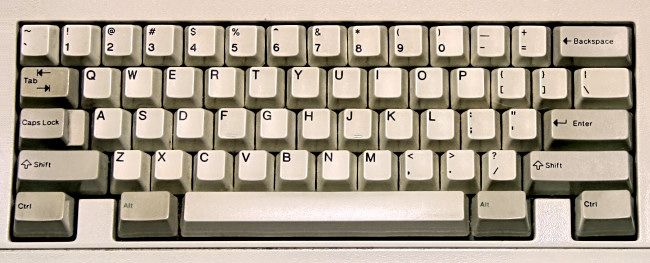 Benj Edwards / How-To Geek
Benj Edwards / How-To Geek
The weirdest thing about the evolution of the QWERTY keyboard layout is that no one knows for certain why the layout took the shape it did. It’s a genuine mystery, despite many seemingly authoritative sources writing to the contrary. In a comprehensive 1983 paper titled The QWERTY Keyboard: A Review, Jan Noyes wrote, “There appears … to be no obvious reason for the placement of letters in the QWERTY layout, and doubts concerning its origin still remain.”
QWERTY 键盘布局演变最奇怪的事情是,没有人确切知道为什么布局会变成现在这样。这是一个真正的谜,尽管许多看似权威的消息来源写道相反。在 1983 年一篇题为 QWERTY 键盘:评论的综合论文中,Jan Noyes 写道:“似乎… 在 QWERTY 布局中放置字母的明显原因并不明显,对其起源的疑问仍然存在。
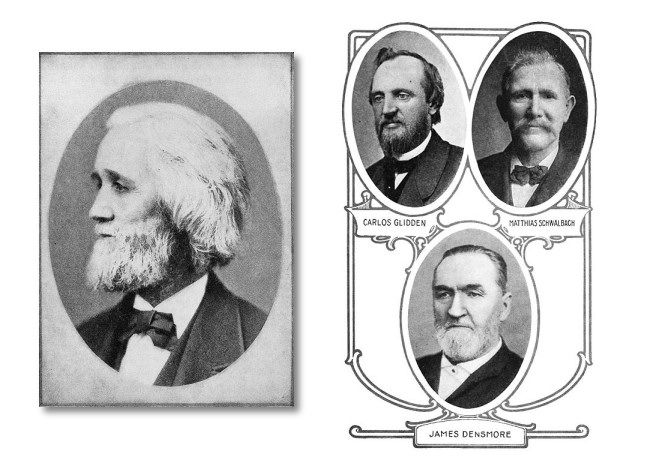
We know who created the QWERTY layout and when it debuted, but the exact meaning behind most of the letter positions within the layout itself has been lost to history. None of the keyboard’s inventors left a record explaining the layout before they died. “The origin is obscure and the historians disagree,” wrote Roy T. Griffith in 1949. As a result, it’s been the subject of frequent speculation for the past 100 years. Here’s what we do know about it.
我们知道是谁创造了 QWERTY 布局以及它何时首次亮相,但布局本身中大多数字母位置背后的确切含义已经消失在历史中。键盘的发明者在去世前都没有留下解释布局的记录。“起源不明,历史学家不同意,” 罗伊・T・格里菲斯(Roy T. Griffith)在 1949 年写道。因此,在过去的 100 年里,它一直是人们频繁猜测的主题。以下是我们所知道的。
The Story of QWERTY as We Understand It 我们所理解的 QWERTY 的故事
The road to QWERTY began around 1867 when a Milwaukee-based newspaper publisher and inventor named Christopher Latham Sholes began working on a typing machine with the help of Carlos Glidden, Matthias Schwalbach, and Samuel W. Soulé.
QWERTY 的道路始于 1867 年左右,当时一位名叫克里斯托弗・莱瑟姆・肖尔斯 (Christopher Latham Sholes) 的密尔沃基报纸出版商和发明家在卡洛斯・格利登 (Carlos Glidden)、马蒂亚斯・施瓦尔巴赫 (Matthias Schwalbach) 和塞缪尔・苏莱 (Samuel W. Soulé) 的帮助下开始研究打字机。
Sholes wasn’t the very first person to create a typewriter, but his innovations lead to the first successful commercial typewriter model in 1874, the Sholes and Glidden Type-Writer, commercialized with the help of businessman James Densmore.
肖尔斯并不是第一个创造打字机的人,但他的创新导致了 1874 年第一款成功的商用打字机型号,即肖尔斯和格利登打字机,在商人詹姆斯・登斯莫尔的帮助下商业化。
Prior to that, Sholes’ first typewriter prototype (circa 1868), included a keyboard that looked much like a piano’s keys, with a nearly alphabetical arrangement. In 1870-1871, with the help of Matthias Schwalbach, the piano keyboard on the next prototype became four rows of push-button keys, but the keyboard still retained a nearly alphabetical arrangement.
在此之前,肖尔斯的第一台打字机原型(约 1868 年)包括一个看起来很像钢琴键的键盘,几乎是按字母顺序排列的。1870-1871 年,在马蒂亚斯・施瓦尔巴赫(Matthias Schwalbach)的帮助下,下一个原型上的钢琴键盘变成了四排按钮键,但键盘仍然保留了几乎按字母顺序排列的排列方式。
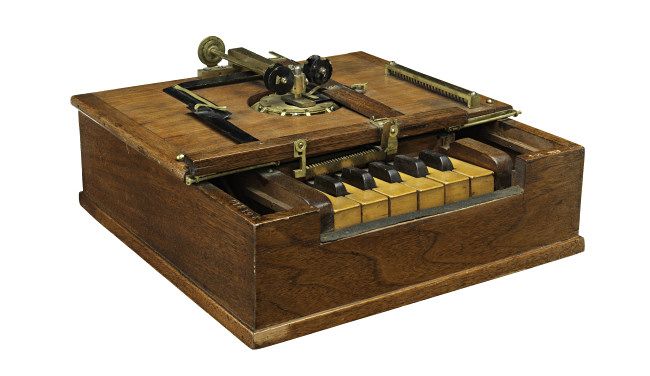 National Museum of American History (Public Domain)
National Museum of American History (Public Domain)
What happened next is shrouded in mystery, as there are no surviving records that describe what took place. “It is positively known that Densmore and Sholes, laboring together, worked out the universal arrangement of the letter keys,” wrote the Herkimer County Historical Society in 1923’s The Story of the Typewriter. “Just how they happened to arrive at this arrangement, however, is a point on which there has always been much speculation.”
接下来发生的事情笼罩在神秘之中,因为没有幸存的记录来描述发生的事情。“众所周知,登斯莫尔和肖尔斯一起努力,制定了字母键的通用排列方式,” 赫基默县历史学会在 1923 年的《打字机的故事》中写道。“然而,他们是如何碰巧达成这种安排的,这一点一直有很多猜测。
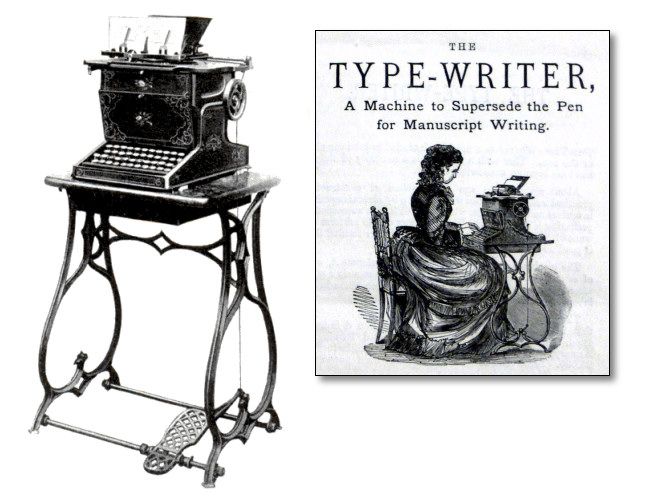 Sholes and Glidden
Sholes and Glidden
Working together in 1872, Sholes and Densmore rearranged the alphabetical keyboard layout into a “QWE.TY” arrangement similar to what we have today (with a period where the “R” would be later—and a hyphen in the top row where the “P” would later emerge). By 1874, the QWERTY layout we know today was mostly in place, with a few differences, such as the location of the “M” and semicolon keys.
1872 年,Sholes 和 Densmore 合作,将按字母顺序排列的键盘布局重新排列为 “QWE.TY“的排列方式类似于我们今天的排列方式(句点”R “在后面 — 顶行的连字符在” P“稍后出现)。到 1874 年,我们今天所知道的 QWERTY 布局基本到位,但有一些不同之处,例如 “M” 和分号键的位置。
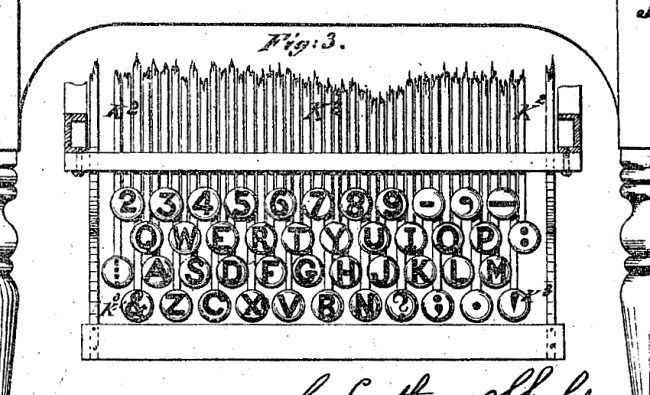 USPTO
USPTO
Remington licensed the typewriter technology from Sholes and Densmore and released the Remington Standard No. 2 in 1878, which proved very successful. A later revision saw the “M” and semicolon keys swap positions (as well as a swap between “X” and “C”), which cemented the QWERTY letter arrangement we know today into its final form.
雷明顿从肖尔斯和登斯莫尔那里获得了打字机技术的许可,并于 1878 年发布了雷明顿标准第 2 号,事实证明非常成功。在后来的修订版中,“M” 和分号键交换了位置(以及 “X” 和 “C” 之间的交换),这巩固了我们今天所知道的 QWERTY 字母排列的最终形式。
But Why QWERTY? 但为什么选择 QWERTY?
Since we don’t have any records from Sholes or Densmore about why they arranged QWERTY that way (and their 1878 patent doesn’t even mention it), historians have had to rely on pure speculation to explain it. And there’s plenty of it out there.
由于我们没有从肖尔斯或登斯莫尔那里得到任何关于他们为什么以这种方式安排 QWERTY 的记录(他们 1878 年的专利甚至没有提到它),历史学家不得不依靠纯粹的推测来解释它。外面有很多这样的东西。
The most common origin theory about the QWERTY layout comes from a series of assumptions made and spread by historians over time. They claim that very early alphabetically-arranged typewriters were prone to jamming and the QWERTY layout fixed this by either jumbling the keyboard to confuse typists and slow them down, or by spreading out the most frequently used letter combinations in English to prevent the typebars in the machine from clashing and getting stuck.
关于 QWERTY 布局的最常见起源理论来自历史学家随着时间的推移做出和传播的一系列假设。他们声称,非常早期的按字母顺序排列的打字机容易出现卡纸,而 QWERTY 布局通过混淆键盘来混淆打字员并减慢他们的速度,或者通过分散最常用的英文字母组合来防止机器中的打字栏发生冲突和卡住。
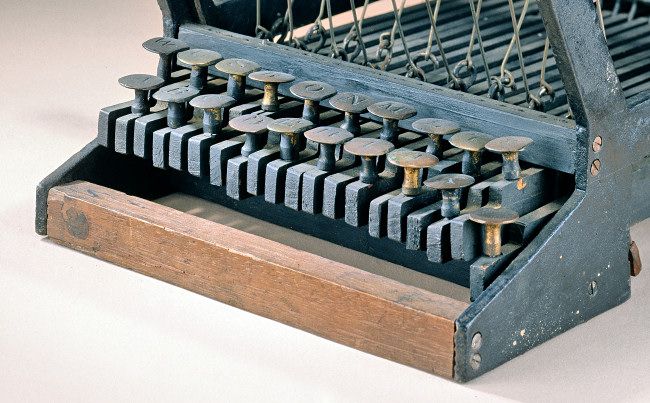 National Museum of American History (Public Domain)
National Museum of American History (Public Domain)
As for slowing typists down, in his 1918 book, The Early History of the Typewriter, Charles Weller (who witnessed and used Sholes’ first typewriter prototypes firsthand), emphasizes the speed of the typewriter: “There were times when everything worked beautifully, and the speed that could be gotten out of it at such times was something marvelous.” Writing speed was the entire point of the typewriter, and there was no desire to slow anyone down. (Interestingly, Weller doesn’t spend any time describing the origins of the QWERTY layout in his book—it was likely a mystery to him too.)
至于放慢打字员的速度,查尔斯・韦勒(Charles Weller)在他 1918 年出版的《打字机的早期历史》(The Early History of the Typewriter)一书中(他亲眼目睹并使用了肖尔斯的第一台打字机原型)强调了打字机的速度:“有时一切都运行得很好,在这种时候可以得到的速度真是太棒了。书写速度是打字机的重点,不想减慢任何人的速度。(有趣的是,Weller 在他的书中没有花时间描述 QWERTY 布局的起源 — 这对他来说也可能是一个谜。
So if they didn’t want to slow typists down, the inventors still could have been trying to prevent jams during speedy usage by spreading out frequently-used letter combinations like “TH.” Some critics have attacked this by pointing out that the letter combination “ER” is one of the most frequently used in English, and yet those two letters are right there, side-by-side, in the QWERTY layout. But if you look back, the original “QWE.TY” layout had placed the “R” in a different location. Other than the “ER” combination, analysis has shown that in general, the QWERTY layout does separate the most frequently-used letter combinations fairly well, at least as understood in 1874.
因此,如果他们不想减慢打字员的速度,发明者仍然可以尝试通过分散常用的字母组合(如 “TH”)来防止在快速使用过程中出现卡纸。一些评论家对此进行了抨击,指出字母组合 “ER” 是英语中最常用的字母组合之一,但这两个字母在 QWERTY 布局中并排存在。但如果你回头看,原来的 “QWE.TY “布局将” R“放置在不同的位置。除了 “ER” 组合之外,分析表明,一般来说,QWERTY 布局确实很好地区分了最常用的字母组合,至少在 1874 年是这样理解的。
But it’s still not a slam dunk. While it’s true that the early typewriter prototypes did jam (according to this first-hand 1918 account), later QWERTY typewriters jammed too if you pushed too many keys at once—this is one of the reasons the inventors quickly transitioned away from a piano keyboard, which made early testers think they could push multiple keys at once. So the jamming issue documented in the historical record may not be related to the letter arrangement at all, but from misuse of the typewriter.
但这仍然不是灌篮高手。虽然早期的打字机原型确实会卡住(根据 1918 年的第一手资料),但后来的 QWERTY 打字机也会卡住,如果你一次按下太多键 — 这是发明者迅速从钢琴键盘过渡的原因之一,这让早期的测试人员认为他们可以同时按下多个键。因此,历史记录中记录的卡纸问题可能与字母排列完全无关,而是由于打字机的误用。
Also, a contradicting statistical study [in 1949](https://aresluna.org/keyboard-secrets/qwerty-killer-patents/1949 Minimotion Griffith.pdf) showed that the QWERTY layout in the type basket (the layout of the typebars in a circle where they strike the paper) of the production 1874 model used more close-in-proximity typebars theoretically prone to clash (26%) than a completely random layout (22%). And to further complicate things, the layout of the keyboard that people press to type did not have to exactly match the layout of the typebars that struck the paper.
此外,1949 年一项相互矛盾的统计研究表明,1874 年生产型号的打字篮(打字杆在敲击纸张的圆圈中的布局)中的 QWERTY 布局使用了理论上容易发生冲突的近距离排 (26%) 而不是完全随机的布局 (22%)。更复杂的是,人们按下打字的键盘布局不必与敲击纸张的打字栏的布局完全匹配。
Overall, with all the back and forth, there’s still no way to conclusively say this was the origin of the layout, but the theory persists because it sounds like a plausible technical explanation for the seemingly random jumble of keys that we all use today.
总的来说,在所有的来回,仍然没有办法最终说这是布局的起源,但这个理论仍然存在,因为它听起来像是我们今天使用的看似随机的混乱键的合理技术解释。
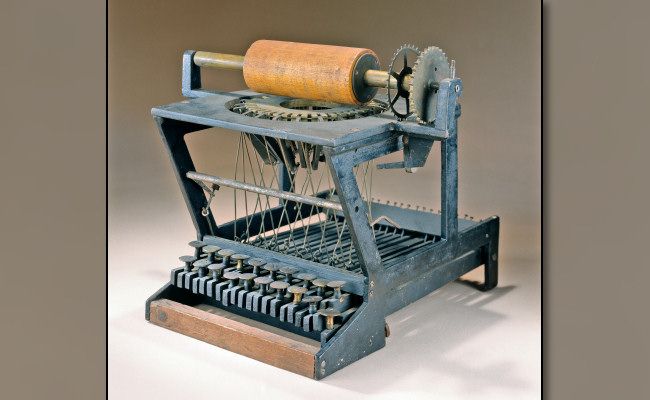 National Museum of American History (Public Domain)
National Museum of American History (Public Domain)
Another more recent theory about the origins of QWERTY comes in relation to the telegraph. In their 2011 paper, “On the Prehistory of QWERTY,” Kyoto University researchers Koichi Yasuoka and Motoko Yasuoka claim that the layout appeared organically following feedback from telegraph operators. They claim, with thin evidence, that a key appeal of the typewriter was in helping telegraph operators transcribe incoming messages from Morse code to regular Latin script quickly. They also claim that because of peculiarities with Morse code, certain key arrangements could speed up the process. Unfortunately, while this has been widely reported to be true, the evidence just isn’t there to support these claims. Like the other theories, it’s more speculation.
另一个关于 QWERTY 起源的最新理论与电报有关。在他们 2011 年的论文《论 QWERTY 的史前史》中,京都大学的研究人员 Koichi Yasuoka 和 Motoko Yasuoka 声称,这种布局是在电报操作员的反馈下有机地出现的。他们声称,在证据不足的情况下,打字机的一个关键吸引力在于帮助电报操作员将收到的消息从摩尔斯电码快速转录为常规拉丁字母。他们还声称,由于摩尔斯电码的特殊性,某些关键安排可以加快这一过程。不幸的是,虽然这已被广泛报道为真实,但没有证据支持这些说法。像其他理论一样,这更多的是猜测。
A much older theory for QWERTY involves a similarity to the “lay” (layout) of a compositor’s type case for lowercase letters, which were arranged more by frequency of usage than by alphabetical order. When arranging type on a printing press, compositors manually selected type letters from a type case and put them in place to spell out words. Sholes, as a publisher, was familiar with the works of compositors (and reportedly once worked as one himself, according to Noyes), so it was a natural analogy to think of pulling type from a case and placing it on a page when operating a typewriter.
QWERTY 的一个更古老的理论涉及与小写字母的字体盒类型情况的 “lay”(布局)的相似性,这些字母更多地按使用频率而不是字母顺序排列。在印刷机上排列字体时,字体盒从字体盒中手动选择字体字母并将它们放置到位以拼写单词。作为出版商,肖尔斯熟悉字体盒的作品(据报道,根据诺伊斯的说法,他自己也曾经工作过),所以在操作打字机时,想到从箱子里拉出字体并将其放在页面上是一个自然的类比。
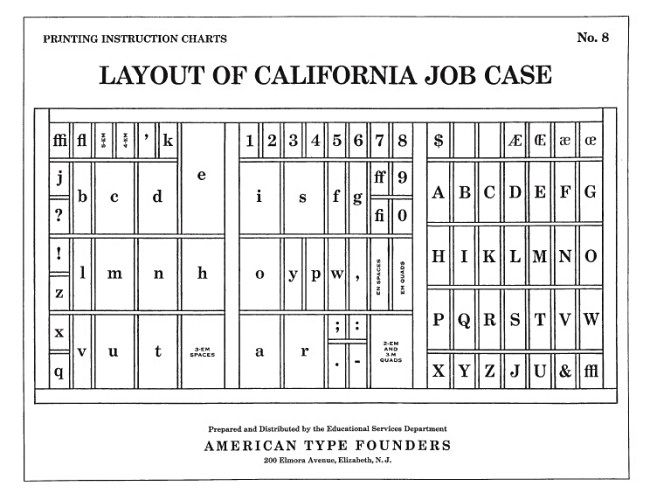 American Type Founders
American Type Founders
One of the most informed opinions we have about the origins of QWERTY comes from historian Richard N. Current, who wrote The Typewriter and the Men Who Made It in 1954. Current had access to letters between Shoals and his business partner James Densmore as they developed their typewriter. Current mentions a few possible theories such as alphabetical order not being ideal for fast typing, as well as avoiding typebar jams—again, with nothing to go on but speculation. But ultimately he says that Sholes and Densmore “finally arranged the typewriter keyboard in the spirit of the printer’s case, though they did not duplicate its particular arrangement.”
关于 QWERTY 的起源,我们最有见地的观点之一来自历史学家 Richard N. Current,他在 1954 年写了《打字机和制造它的人》。Current 在开发打字机时获得了 Shoals 和他的商业伙伴 James Densmore 之间的信件。Current 提到了一些可能的理论,例如字母顺序不适合快速打字,以及避免打字栏堵塞 — 再次,除了猜测之外别无他法。但最终他说,肖尔斯和登斯莫尔 “最终按照打印机外壳的精神布置了打字机键盘,尽管他们没有复制其特定的布置。
Historians have supported and dismissed the QWERTY-type case connection over time, but interestingly, Current’s book holds a potential clue in this theory’s favor that Current didn’t recognize. In a reproduced letter authored by Mark Twain on an early typewriter, Twain writes, “The having been a compositor is likely to be a great help to me, since one chiefly needs swiftness in banging the keys.” This suggests that the QWERTY arrangement reminded Twain of pulling type from a compositor’s type case. But still, since QWERTY doesn’t exactly match any known type case layout, all of this is speculation.
历史学家们一直在支持和反驳 QWERTY 键盘与排字盒之间的联系,但有趣的是,卡伦特(Current)的书中可能提供了支持这一理论的潜在线索,而卡伦特自己并未意识到。在一封马克・吐温(Mark Twain)用早期打字机写的信中,他提到:“过去当过排字工很可能会对我有很大帮助,因为最重要的是输入的快速。” 这表明 QWERTY 键盘的布局让吐温想起了从排字盒中取出活字的情景。但是,由于 QWERTY 键盘的布局并不完全匹配任何已知的排字盒布局,这一切都只是推测。
What seems likely is that Sholes and Densmore began with an alphabetical arrangement and changed it to a layout that matched their mechanical needs and personal comfort, for whatever reasons. In the end, a few alphabetical vestiges remain in the standard layout, but the true secrets QWERTY are buried with Sholes and Densmore, where they will likely stay. As for the persistence of the myths and speculation about QWERTY, it’s difficult for historians and experts to admit that sometimes they just don’t know, and the fact that they will never know the origin of something so fundamental is doubly frustrating. In the face of that uncertainty, it’s easy to grab onto the comfort of a false narrative instead.
似乎很有可能的是,Sholes 和 Densmore 从字母顺序排列开始,然后出于某种原因将其更改为符合他们的机械需求和个人舒适度的布局。最后,一些按字母顺序排列的遗迹保留在标准布局中,但真正的秘密 QWERTY 与 Sholes 和 Densmore 一起被埋葬,它们可能会留在那里。至于关于 QWERTY 的神话和猜测的持续存在,历史学家和专家很难承认有时他们只是不知道,而他们永远不会知道如此基本的东西的起源这一事实令人倍感沮丧。面对这种不确定性,人们很容易抓住虚假叙述的安慰。
From Typewriters to Computers 从打字机到电脑
From the late 1800s on, typewriters exploded in popularity. Despite competing alternative keyboard layouts, QWERTY held on because people learned it first, and it made sense to not have to learn a completely new layout on a different machine. Other manufacturers imitated the Remington standard, and in the absence of patent enforcement of the layout, it proliferated.
从 1800 年代后期开始,打字机大受欢迎。尽管有竞争的替代键盘布局,QWERTY 还是坚持了下来,因为人们首先学会了它,而且不必在另一台机器上学习全新的布局是有道理的。其他制造商模仿雷明顿标准,在布局没有专利执法的情况下,它激增。
In the 1920s, the Teletype corporation created teleprinters with keyboard layouts based on standard typewriters, and they borrowed the QWERTY layout along the way. By the 1960s, people often used Teletypes as computer terminals, so the standard made its way to computers and then personal computers in the 1970s. QWERTY received a further boost when IBM incorporated it into its 101-key Enhanced Keyboard layout, which became the basis of the desktop computer keyboard standards we use today.
在 1920 年代,电传打字机公司创造了基于标准打字机的键盘布局的电传打印机,并在此过程中借用了 QWERTY 布局。到 1960 年代,人们经常使用电传打字机作为计算机终端,因此该标准在 1970 年代进入了计算机,然后是个人计算机。 当 IBM 将其纳入其 101 键增强型键盘布局时,QWERTY 得到了进一步的推动,这成为我们今天使用的台式计算机键盘标准的基础。
As much as we in America think of QWERTY as a universal given, different keyboard layouts reign in different parts of the world. For example, France, Belgium, and some African countries use AZERTY. Germany and Austria use QWERTZ. But they’re all derivatives of the original QWERTY layout—the same one cobbled together by Sholes and Densmore way back in 1874. Those men took QWERTY’s secrets with them, but their invention’s impact will likely continue as long as we use keyboards, which could be decades or even centuries to come.
尽管我们美国人认为 QWERTY 是一个普遍的给定,但不同的键盘布局在世界不同地区占主导地位。例如,法国、比利时和一些非洲国家使用 AZERTY。德国和奥地利使用 QWERTZ。但它们都是原始 QWERTY 布局的衍生物 — 与 Sholes 和 Densmore 在 1874 年拼凑在一起的布局相同。这些人带走了 QWERTY 的秘密,但只要我们使用键盘,他们的发明的影响可能会持续下去,这可能是几十年甚至几个世纪。
via:
- The QWERTY Keyboard Is Tech’s Biggest Unsolved Mystery By Benj Edwards Updated Mar 28, 2022


















